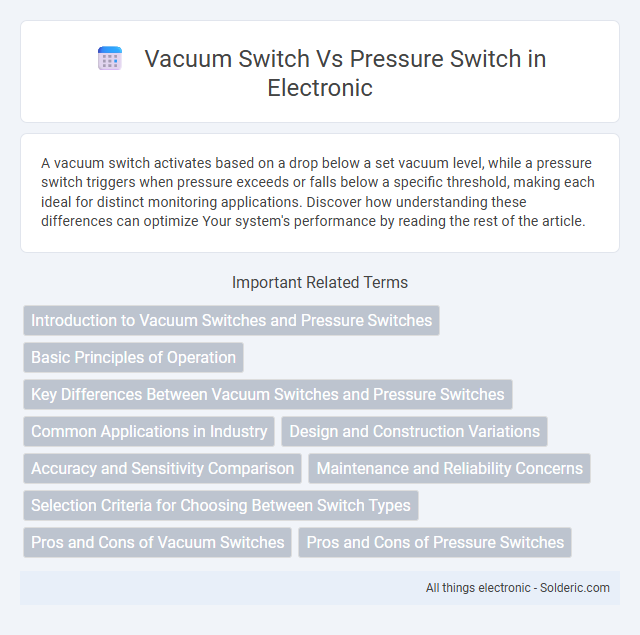A vacuum switch activates based on a drop below a set vacuum level, while a pressure switch triggers when pressure exceeds or falls below a specific threshold, making each ideal for distinct monitoring applications. Discover how understanding these differences can optimize Your system's performance by reading the rest of the article.
Comparison Table
| Feature | Vacuum Switch | Pressure Switch |
|---|---|---|
| Function | Detects and controls vacuum (negative pressure) | Detects and controls positive pressure levels |
| Measurement Range | Typically 0 to -1 bar (vacuum range) | Typically 0 to several hundred bar (pressure range) |
| Applications | Vacuum pumps, HVAC, medical devices | Hydraulic systems, compressors, water pumps |
| Operating Principle | Senses negative pressure to trigger switching | Senses positive pressure to trigger switching |
| Switching Type | Usually SPDT or SPST contacts | Usually SPDT or SPST contacts |
| Typical Materials | Corrosion-resistant diaphragms and housings | Robust housings for high-pressure environments |
| Key Benefits | Protects systems from vacuum loss | Prevents overpressure damage |
| Sensitivity | Calibrated for low vacuum thresholds | Calibrated for varied pressure thresholds |
Introduction to Vacuum Switches and Pressure Switches
Vacuum switches and pressure switches are essential control devices used to monitor and maintain specific vacuum or pressure levels within systems. Vacuum switches detect and activate at preset vacuum thresholds, ensuring safe operation in applications like HVAC, industrial processes, and automotive systems. Pressure switches respond to changes in fluid or gas pressure by triggering electrical contacts, commonly utilized in compressors, pumps, and hydraulic systems to prevent overpressure conditions.
Basic Principles of Operation
A vacuum switch detects and monitors negative pressure or vacuum levels by activating an electrical circuit when the pressure drops below a preset threshold, using a diaphragm or bellows that responds to changes in atmospheric pressure. In contrast, a pressure switch measures positive pressure within a system and triggers a circuit based on preset pressure limits by utilizing mechanical components like pistons or diaphragms to sense fluid or air pressure. Your choice between a vacuum switch and a pressure switch depends on whether you need to control or monitor vacuum conditions or positive pressures in your application.
Key Differences Between Vacuum Switches and Pressure Switches
Vacuum switches measure and respond to negative pressure or suction levels below atmospheric pressure, while pressure switches detect and react to positive pressure above atmospheric levels. Vacuum switches are commonly used in applications like HVAC systems and vacuum pumps, whereas pressure switches find frequent use in hydraulic systems, compressors, and fluid control. Key differences include their sensing ranges, operating principles, and typical industrial applications, highlighting their distinct roles in pressure monitoring and control.
Common Applications in Industry
Vacuum switches are commonly used in HVAC systems, vacuum packaging, and medical equipment to monitor and control vacuum pressure levels, ensuring operational safety and efficiency. Pressure switches find widespread application in hydraulic systems, air compressors, and water pumps to detect and maintain specific pressure thresholds, preventing equipment damage and process failures. Your choice between a vacuum switch and a pressure switch depends on the specific pressure range and operational requirements of your industrial application.
Design and Construction Variations
Vacuum switches are designed with sensitive diaphragms or bellows to detect low-pressure conditions, often incorporating hermetically sealed contacts to prevent contamination. Pressure switches typically feature robust springs and pistons or diaphragms calibrated for higher pressure ranges, ensuring durability in industrial environments. Differences in materials and sealing techniques reflect each switch's purpose, where vacuum switches prioritize airtight construction while pressure switches emphasize mechanical strength.
Accuracy and Sensitivity Comparison
Vacuum switches typically offer higher sensitivity to small pressure changes in low-pressure environments, achieving more accurate detection of vacuum levels. Pressure switches are designed to operate over a broader pressure range but may sacrifice some precision at very low pressures. Your choice between them should consider the required measurement accuracy and responsiveness for the specific application.
Maintenance and Reliability Concerns
Vacuum switches generally require less frequent maintenance compared to pressure switches due to fewer moving parts and lower susceptibility to wear caused by fluid or particulate contamination. Pressure switches, exposed to variable pressures and potential chemical corrosion, often demand regular calibration and inspection to maintain accuracy and prevent failure. Reliability in vacuum switches is enhanced by their simpler design, whereas pressure switches require robust sealing and sensitive components, making them more prone to maintenance issues over time.
Selection Criteria for Choosing Between Switch Types
Choosing between a vacuum switch and a pressure switch depends primarily on the monitoring environment and application requirements; vacuum switches are optimized for detecting negative pressure or vacuum conditions below atmospheric pressure, while pressure switches are designed for positive pressure applications above atmospheric levels. Key selection criteria include the operating pressure range, sensitivity, response time, and the type of fluid or gas being measured. Material compatibility, electrical ratings, and environmental factors such as temperature and vibration resistance also play critical roles in ensuring reliable and accurate switch performance.
Pros and Cons of Vacuum Switches
Vacuum switches offer precise control and reliability in monitoring low-pressure systems, making them ideal for HVAC and industrial applications requiring accurate vacuum level detection. Their main advantages include high sensitivity, durability under harsh conditions, and energy efficiency due to low power consumption. However, vacuum switches can be more expensive than pressure switches, have limited compatibility with high-pressure environments, and may require regular calibration to maintain accuracy.
Pros and Cons of Pressure Switches
Pressure switches offer reliable monitoring of fluid or gas pressure levels with quick response times, making them ideal for protecting equipment from overpressure conditions. However, they can be susceptible to wear and calibration drift due to mechanical components, which may require regular maintenance and recalibration to ensure accuracy. Your choice depends on application needs, as pressure switches excel in straightforward pressure control but may not perform well in vacuum or low-pressure scenarios where vacuum switches are more suitable.
vacuum switch vs pressure switch Infographic

 solderic.com
solderic.com